Poste Italiane Bundle
Who Does Poste Italiane Serve? Unveiling the Customer Landscape
In today's dynamic market, understanding your customer base is crucial, and for a company like Poste Italiane, it's essential. With a history spanning over 160 years, Poste Italiane has evolved from a postal service to a multifaceted provider of financial, insurance, and telecommunications solutions. This transformation necessitates a deep dive into its Poste Italiane SWOT Analysis, customer demographics, and target market.
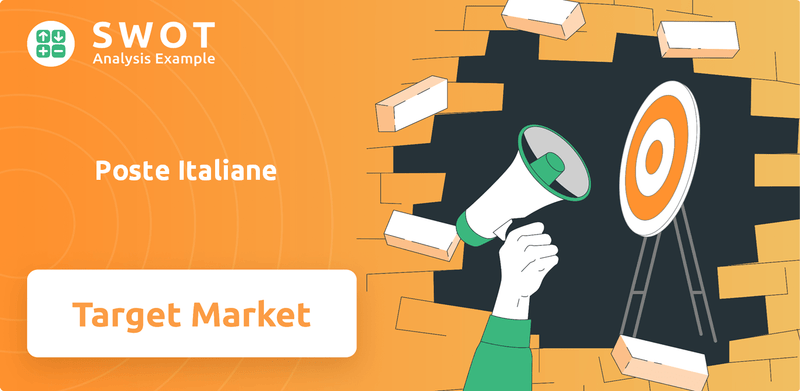
This exploration will uncover the diverse Poste Italiane customer profile, from those utilizing traditional postal services to those engaging with its financial products. We'll examine Poste Italiane customer segmentation strategies and how the company adapts to meet the evolving needs of its Poste Italiane audience, considering factors like Poste Italiane customer age range, income levels, and location data within Italy. Understanding Poste Italiane market analysis is key to grasping its strategic direction.
Who Are Poste Italiane’s Main Customers?
Understanding the customer demographics of Poste Italiane is crucial for grasping its market position. The company serves a wide array of customers, including both individual consumers (B2C) and businesses (B2B). This broad reach is a key aspect of its business model, reflecting the diverse range of services it offers, from postal and parcel delivery to financial and insurance products.
Poste Italiane's strategy for 2024-2028 emphasizes a focus on micro and small business clients, alongside optimizing its coverage of retail clients. This indicates a targeted approach within its expansive customer base. Historically, the company has aimed to serve all demographics, geographic locations, and psychographics across Italy, including urban and rural areas, showcasing a comprehensive customer segmentation strategy.
The company's primary customer segments are organized around its key business units: Mail, Parcel & Distribution; Financial Services; Insurance Services; and Postepay Services. Each segment caters to distinct customer needs, contributing to the overall customer profile of Poste Italiane.
This segment focuses on postal services and parcel delivery, with a strong emphasis on e-commerce driven growth. In Q1 2025, revenues in this segment grew by 4.6% year-over-year, reaching €934 million, primarily due to increased parcel volumes. The company aims for parcel business revenue to account for over 50% of the Mail and Parcel sector by 2025.
Financial Services, including BancoPosta, is a core revenue generator. In Q1 2025, this segment saw a 5% revenue increase, reaching €1.3 billion. The company focuses on client segmentation to allocate specialized financial advisors, catering to diverse customer needs within this segment. This segment targets a wide range of customers seeking banking and financial products.
Postepay Services, encompassing payments, mobile, and energy services, has experienced robust growth. Revenues increased by 9.5% to €1.6 billion in FY2024, driven by transaction value growth and the expansion of energy services. The energy business client base grew to approximately 800,000 clients in Q1 2025, nearly doubling from the previous year. This segment caters to customers seeking digital payment solutions and energy services.
This segment provides insurance products to both individual and business customers. Specific details on customer demographics and revenue figures for this segment are not available in the provided data, but it is a key component of Poste Italiane's diversified service portfolio.
Poste Italiane's customer base is extensive, spanning various demographics and geographic locations. The company's strategy involves targeted initiatives for specific segments, such as micro-small businesses and retail clients. The focus on growth areas like parcels and digital services demonstrates its adaptation to market trends.
- The company's customer segmentation strategy is broad, encompassing both B2C and B2B clients.
- Financial Services and Postepay Services are critical revenue drivers, reflecting a diverse customer base.
- The growth in parcel volume and digital services indicates a response to changing customer behaviors.
Poste Italiane SWOT Analysis
- Complete SWOT Breakdown
- Fully Customizable
- Editable in Excel & Word
- Professional Formatting
- Investor-Ready Format
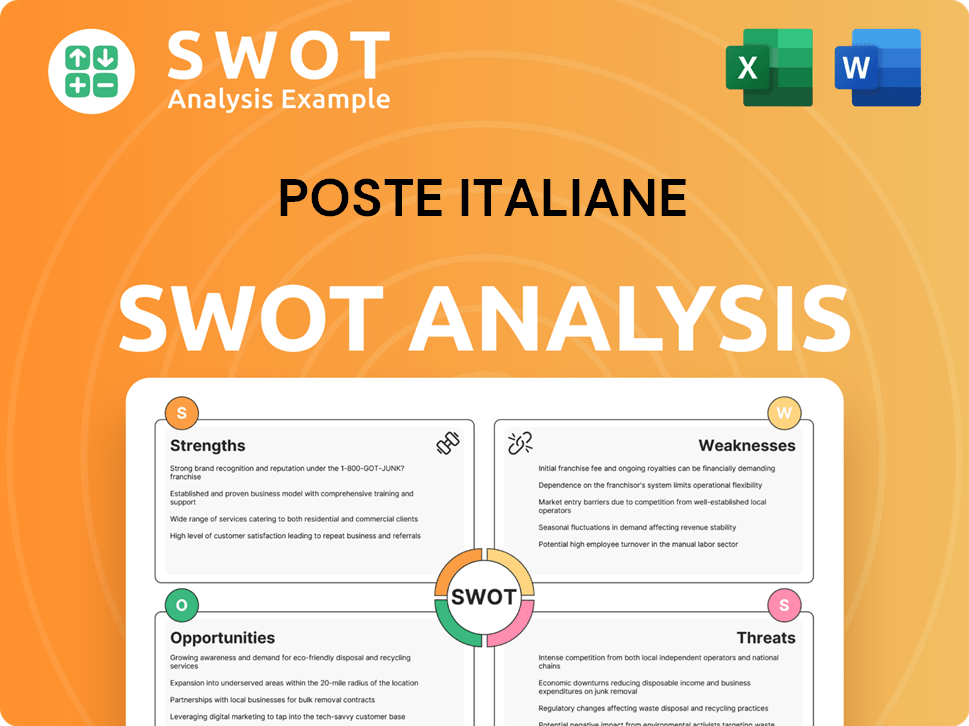
What Do Poste Italiane’s Customers Want?
Understanding the needs and preferences of its diverse customer base is crucial for the success of Poste Italiane. The company's strategic direction is heavily influenced by these evolving customer demands, which span from basic postal services to sophisticated financial and digital solutions. This customer-centric approach drives Poste Italiane's investments and innovations, particularly in its 'phygital' platform, which integrates physical post offices with digital infrastructure.
Poste Italiane's customer base is driven by the need for convenience, efficiency, and a seamless experience across all touchpoints. This has led to a significant focus on digital transformation and the development of integrated services. The company continuously adapts its offerings to meet the changing expectations of its customers, ensuring it remains relevant and competitive in the market.
The company's ability to meet these diverse needs is reflected in its strategic initiatives, such as expanding its e-commerce logistics and financial services. By understanding the specific requirements of different customer segments, Poste Italiane aims to enhance customer satisfaction and loyalty, driving long-term growth and profitability. This customer-centric strategy is key to its continued success.
In the Mail, Parcel & Distribution segment, customers increasingly expect efficient parcel delivery options. Poste Italiane is focused on meeting this demand by improving its delivery services. This includes aiming to increase the volume of parcels delivered by its employees to 42% in 2025, up from 39% in 2024.
Poste Italiane is also investing in micro-fulfillment services to provide faster delivery options. These services aim to deliver parcels within 4 hours, meeting the growing demand for rapid e-commerce fulfillment. Partnerships with e-retailers like Amazon support these efforts.
Customers seeking reliable investment products and accessible loan options are a key focus for Poste Italiane. The company is tailoring its offerings to meet these needs. For example, the launch of the BancoPosta Target Premium 2029 fund for Premium customers and the introduction of baskets of investment funds in early 2025.
Poste Italiane aims to achieve customer portfolio diversification across savings, insurance, and investment products. This strategy helps customers manage their financial risks and achieve their investment goals. The company’s focus on diversification is a key element of its financial services strategy.
In Postepay Services, customers demand everyday digital payment solutions and integrated home services. The upcoming SuperApp is designed to be a single access point for the entire Poste Italiane ecosystem. This will maximize cross-selling and up-selling potential by offering a harmonized customer experience across all business lines.
The SuperApp will be customized to individual client profiles and leverage AI to provide a personalized experience. This will allow Poste Italiane to better understand and cater to the specific needs of its customers. This is a core element of Poste Italiane's customer segmentation strategy.
Poste Italiane's focus on understanding its customer demographics and adapting its services to meet their needs is central to its business model. The company continuously analyzes its Poste Italiane customer profile to refine its offerings and improve customer satisfaction. By understanding the Poste Italiane target market, the company can effectively tailor its services and maintain its competitive edge. This customer-centric approach is critical for long-term growth.
Poste Italiane's customer base has varied preferences, including the need for efficient and convenient services. The company is responding to these needs through digital transformation and integrated service offerings. These key preferences shape Poste Italiane's strategic decisions.
- Convenience: Customers seek easy-to-use services across multiple touchpoints.
- Efficiency: Rapid and reliable service delivery is a priority, especially in parcel delivery.
- Digital Solutions: Demand for digital payment options and integrated home services is growing.
- Personalization: Customers want tailored experiences and customized solutions.
- Financial Security: Reliable investment products and accessible loan options are essential.
Poste Italiane PESTLE Analysis
- Covers All 6 PESTLE Categories
- No Research Needed – Save Hours of Work
- Built by Experts, Trusted by Consultants
- Instant Download, Ready to Use
- 100% Editable, Fully Customizable
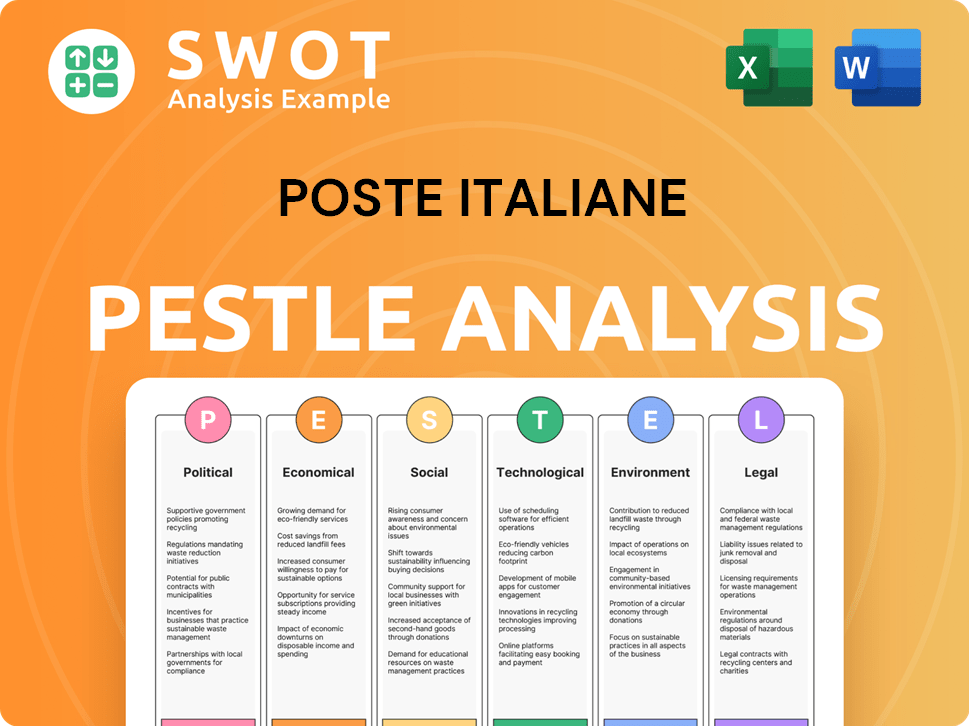
Where does Poste Italiane operate?
The primary geographical market for Poste Italiane is Italy. It functions as the national postal service and a leading financial services provider there. This strong presence in Italy is a key aspect of its business strategy.
Poste Italiane has a vast distribution network within Italy. This includes approximately 12,755 post offices and 51,000 third-party network points, like tobacconists and bars. This extensive reach supports its 'phygital' approach, ensuring services are accessible to a wide range of customers.
While focused on Italy, Poste Italiane also has a presence in other parts of Europe, the Americas, and Asia. This is especially true for its Mail, Parcels, and Distribution segment. The company aims to grow its international inbound business, with plans for expansion in 2025.
Poste Italiane aims to serve all areas within Italy, including major cities and smaller towns. This comprehensive coverage demonstrates its commitment to providing services across the entire country. This wide reach is essential for understanding the Poste Italiane customer demographics.
The company is working to reduce the digital divide through the Polis Project. By 2026, around 7,000 post offices in small municipalities will become digital service hubs. This project is a key part of the company's strategy to reach its Poste Italiane target market.
The company's initiatives, like the Polis Project, highlight its dedication to equitable service access. This approach is crucial for fostering social cohesion across different regions of Italy, which is important for Poste Italiane customer segmentation.
Poste Italiane continues to evolve its services to meet the needs of its diverse customer base. This includes expanding its digital offerings and improving accessibility across its entire network. The company's strategy, as discussed in Brief History of Poste Italiane, is to adapt to changing market demands.
- Focus on digital transformation to improve customer experience.
- Investment in infrastructure to support new services.
- Strategic partnerships to enhance service offerings.
- Continuous improvement of customer service channels.
Poste Italiane Business Model Canvas
- Complete 9-Block Business Model Canvas
- Effortlessly Communicate Your Business Strategy
- Investor-Ready BMC Format
- 100% Editable and Customizable
- Clear and Structured Layout
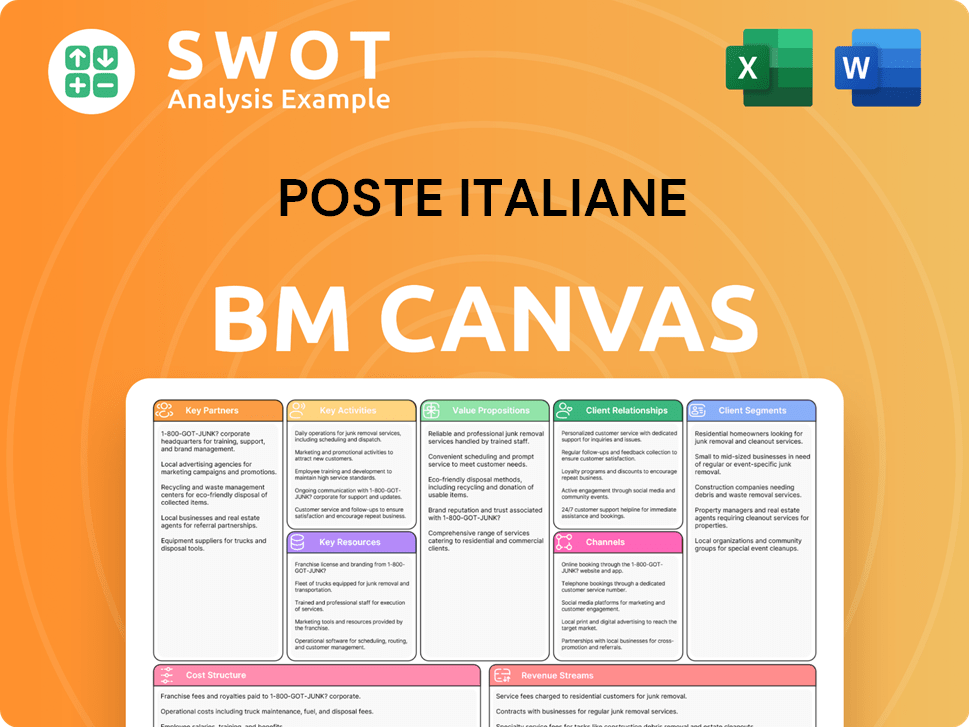
How Does Poste Italiane Win & Keep Customers?
Poste Italiane's customer acquisition and retention strategies are deeply rooted in its 'phygital' platform, which blends physical and digital channels. This approach focuses on optimizing retail client coverage and transforming post offices into spaces that foster stronger customer relationships. The company is actively expanding its services and enhancing its digital presence to meet the evolving needs of its diverse customer base.
A key element of this strategy involves a significant digital transformation, highlighted by the development of a new SuperApp. This app is designed to be a central access point for all services, boosting cross-selling and up-selling opportunities by customizing offerings to individual client profiles. Furthermore, Poste Italiane leverages its omnichannel platform and AI-driven campaign tools to connect with customers, aiming to increase the value of digital payments.
In terms of customer retention, Poste Italiane focuses on increasing value per client by meeting growing needs. This includes refining its customer segmentation in Financial Services and expanding offerings in insurance and energy services. The company's strategic investments, such as the stake in TIM, aim to generate synergies that enhance customer offerings and support market consolidation.
Poste Italiane is transforming its post offices to become more relational spaces. It focuses on micro-small business clients by introducing 400 new 'Punto Poste Business Counters' within main post offices. These counters will be staffed with dedicated consultants, enhancing customer service and support. This strategy aims to improve customer relationships and increase client satisfaction.
The company is developing a new SuperApp, integrating a digital payment wallet and AI capabilities. This SuperApp will serve as a unique access point to the entire Poste Italiane ecosystem. This strategy aims to provide a seamless customer experience and maximize cross-selling and up-selling potential.
Poste Italiane is evolving its client segmentation in Financial Services to better meet customer needs. This involves allocating customers to specialized financial advisors. The focus is on delivering tailored services and advice, which should improve customer satisfaction and retention rates. This approach supports a deeper understanding of the Growth Strategy of Poste Italiane.
The company is leveraging increasing demand in the Protection business within its Insurance Services. There is a focus on maintaining steady growth in the Life Investment & Pension business. The strong performance in Postepay Services, driven by transaction value growth, is a key indicator of successful retention.
Poste Italiane uses a multi-channel approach to acquire customers. This includes optimizing its physical post office network and expanding its digital presence. The company is investing in AI-driven campaigns to attract new customers.
The development of the SuperApp is a central part of Poste Italiane's digital transformation. This will allow for customized service offerings. The SuperApp will integrate various services, creating a seamless user experience.
Poste Italiane segments its customers to provide tailored financial services. This involves allocating customers to specialized financial advisors. The goal is to better address individual customer needs and preferences.
Poste Italiane is expanding its services to include energy services. Approximately 800,000 energy clients were acquired in Q1 2025. This diversification supports customer retention by providing a broader range of offerings.
The acquisition of a stake in TIM aims to generate synergies. These synergies should enhance customer offerings and support market consolidation. Strategic investments play a crucial role in customer retention and acquisition.
Poste Italiane is targeting micro-small businesses with dedicated services. The introduction of 'Punto Poste Business Counters' in main post offices is a key initiative. This focus aims to strengthen relationships with business clients.
Poste Italiane Porter's Five Forces Analysis
- Covers All 5 Competitive Forces in Detail
- Structured for Consultants, Students, and Founders
- 100% Editable in Microsoft Word & Excel
- Instant Digital Download – Use Immediately
- Compatible with Mac & PC – Fully Unlocked
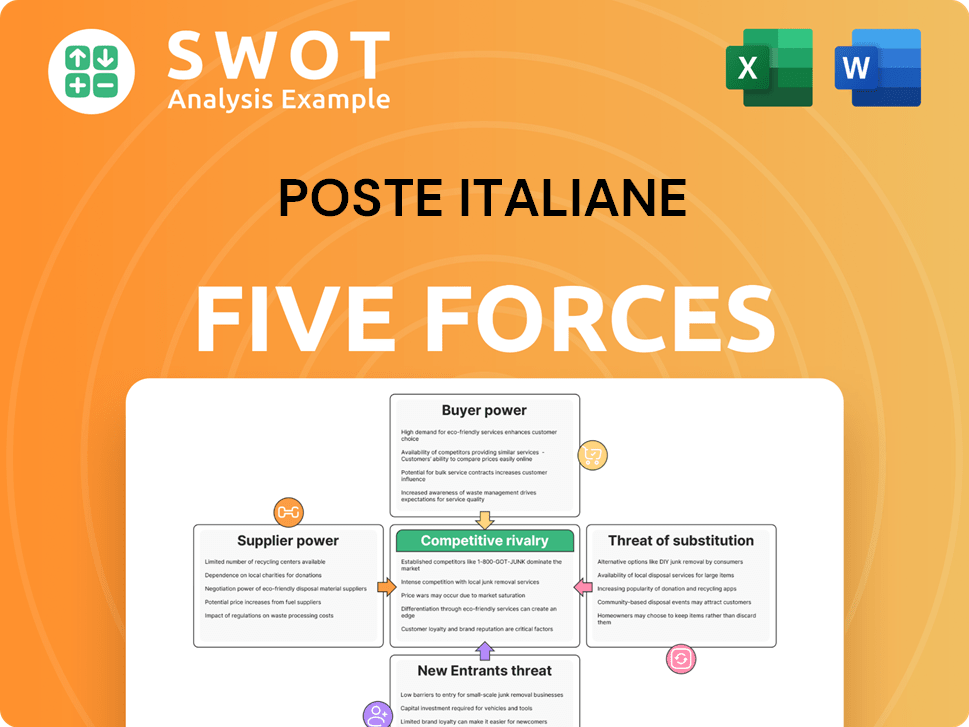
Related Blogs
- What are Mission Vision & Core Values of Poste Italiane Company?
- What is Competitive Landscape of Poste Italiane Company?
- What is Growth Strategy and Future Prospects of Poste Italiane Company?
- How Does Poste Italiane Company Work?
- What is Sales and Marketing Strategy of Poste Italiane Company?
- What is Brief History of Poste Italiane Company?
- Who Owns Poste Italiane Company?
Disclaimer
All information, articles, and product details provided on this website are for general informational and educational purposes only. We do not claim any ownership over, nor do we intend to infringe upon, any trademarks, copyrights, logos, brand names, or other intellectual property mentioned or depicted on this site. Such intellectual property remains the property of its respective owners, and any references here are made solely for identification or informational purposes, without implying any affiliation, endorsement, or partnership.
We make no representations or warranties, express or implied, regarding the accuracy, completeness, or suitability of any content or products presented. Nothing on this website should be construed as legal, tax, investment, financial, medical, or other professional advice. In addition, no part of this site—including articles or product references—constitutes a solicitation, recommendation, endorsement, advertisement, or offer to buy or sell any securities, franchises, or other financial instruments, particularly in jurisdictions where such activity would be unlawful.
All content is of a general nature and may not address the specific circumstances of any individual or entity. It is not a substitute for professional advice or services. Any actions you take based on the information provided here are strictly at your own risk. You accept full responsibility for any decisions or outcomes arising from your use of this website and agree to release us from any liability in connection with your use of, or reliance upon, the content or products found herein.